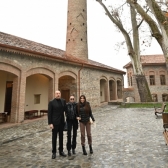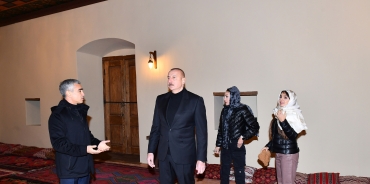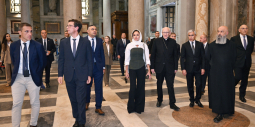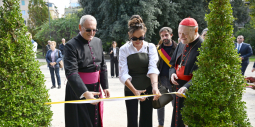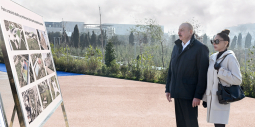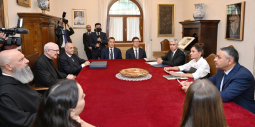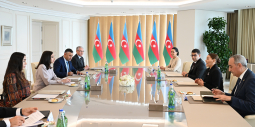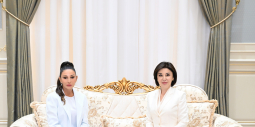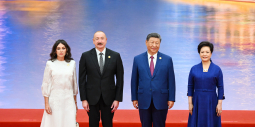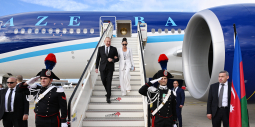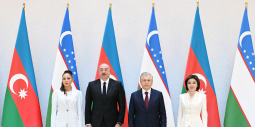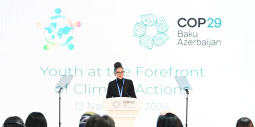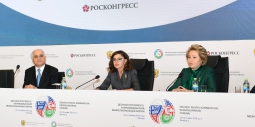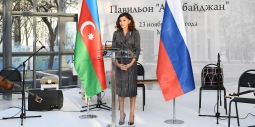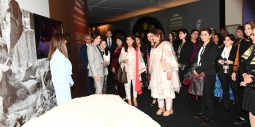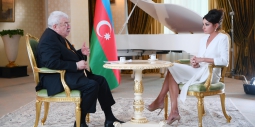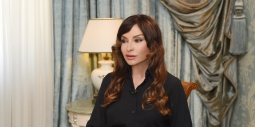Shaki Khan’s Mosque Complex was restored by Heydar Aliyev Foundation
02.12.2022President of the Republic of Azerbaijan Ilham Aliyev, First Lady Mehriban Aliyeva and their daughter Leyla Aliyeva have viewed the restoration work carried out by the Heydar Aliyev Foundation at the Shaki Khan’s Mosque Complex.
Assistant to the President Anar Alakbarov informed President Ilham Aliyev, First Lady Mehriban Aliyeva and Leyla Aliyeva of the restoration work carried out in the complex.
The Shaki Khan mosque complex in the reserve has been put into use after major restoration. The restoration work in the historic Shaki Khan Mosque was launched by the Heydar Aliyev Foundation in May 2021. The Heydar Aliyev Foundation has also supported research on skeletal samples discovered during excavations and believed to belong to the Shaki Khan’s family.
It was noted that restoration work in the mosque complex was carried out on the basis of a project prepared by the Architecture and Civil Engineering University on the order of the State Tourism Agency. The mosque is listed as a monument of national importance and dates back to the period of khanates (1745-1750). According to historical sources and inscriptions on it, the mosque was built by Haji Mahammadhuseyn Khan.
The 13 main graves in the cemetery located next to the mosque belong to representatives of the Khan’s dynasty. The cemetery was named Khan’s Cemetery because only members of the Khan’s dynasty were buried in it.
It was pointed out that the 21-meter minaret of the mosque was built using baked bricks and lime mortar. There is a circular staircase reaching the balcony here. The arched porch on the front façade of the mosque gives the mosque particular beauty. The mosque, designed in 1981, was never restored in the following years.
As part of the restoration work launched by the Heydar Aliyev Foundation in 2021, 3D measurement work was carried out in the Khan mosque complex located on the premises of the “Yukhari Bash” National Historical-Architectural Reserve in the city of Shaki. These activities were important in terms of reinstating the initial appearance of the mosque complex. The buildings located in the area, including the main building and minaret of the mosque, auxiliary buildings, the fence around the complex and the cemetery, were scanned and a 3D model of the mosque was prepared. During the restoration work carried out on the basis of the initial appearance of the mosque complex, the bricks that became unusable due to climate impacts were replaced with new ones and masonry work was carried out using baked bricks. In order to protect the bricks of the minaret from erosion, an insulating layer was created using special materials. At the same time, the windows used during the initial construction of the mosque and the door used by Mahammadhuseyn Khan were restored. Based on architect feedback, the original appearance of two of the windows was returned using shabaka, one of the traditional local architectural attributes.
Since there were no available photos of the mosque’s ceiling, the State Tourism Agency and designers made a joint decision to assemble a new ceiling reminiscent of the shabaka structure used in the Godak minaret mosque and the Shaki Khan Palace. The interior and exterior walls of the building were restored based on the photos of 1961.
It was noted that a new pool was built instead of the old one in the courtyard of the mosque. A protection zone has been created around the Khan’s plane and other trees in the courtyard. In accordance with the project, a ceremonial hall, an ablution room and administrative rooms have been built in the territory of the mosque. The ancient entrance gate and stairs of the mosque have been restored, including the tombstones in the Khan’s cemetery located south of it.
In June 2021, as part of the restoration work in the mosque, large raft stones were discovered underneath the sanctuary. For this reason, restoration work in that section was suspended and inspection carried out by the Shaki archaeological expedition. The discovery of 52 beads and a bronze rosary in the grave suggested that the buried person was of a high religious or public status. Proceeding from such a possibility, as well as Salman Mumtaz’s records, and the presence of information carried out on the basis of the information found in other different studies of the burial of Shaki Khan Mahammadhuseyn Mushtagh under the sanctuary of the Khan Mosque, additional inspections were carried out on the findings. To support experts, with the assistance of the Heydar Aliyev Foundation, samples were taken from the discovered skeleton bones and sent to the laboratory of Oxford University in Great Britain for radiocarbon and genetic analysis. Researches and genetic analyses were conducted in Great Britain, Austria, Estonia and Turkiye on the basis of discovered skeleton samples and those taken from other graves of the Khan’s dynasty. The results of the laboratory analysis and the expert opinion of the ANAS Institute of Archaeology, Ethnography and Anthropology proved that the discovered grave belongs to Mahammadhuseyn Khan of Shaki.
It was also mentioned that a museum had been established on the premises of the mosque complex with the support of the Heydar Aliyev Foundation. The museum displays different exhibits from the time of the Shaki Khanate, as well as material and cultural artifacts collected from various sources. The museum demonstrates the special role the creation and formation of the Shaki Khanate have played in the history of Azerbaijani national statehood. Exhibited on the first floor of the two-level museum are copper vessels, national costumes, jewelry from the time of the Shaki Khanate, wall-mounted mirrors that used to decorate the houses of Shaki merchants in the 18th century, chests that were placed in front of them according to the Shaki tradition, and samples of the traditional art of Shaki kalaghayi. The electronic board on the first floor of the museum displays information about the history, political, socioeconomic life, culture of the Shaki khanate and Shaki khans in Azerbaijani and English languages. Displayed on the second floor are Shaki carpets, various carpet-making accessories, the book “History of the Shaki Khans” by Abdullatif Afandi, as well as publications from the time of the Shaki Khanate, a shabaka sample, 18th century coins used by Shaki khans, samples of weapons from the 18-19th centuries.
One of the main areas of the museum is the Khan’s room on the second floor. The room shows how Shaki Khan Mahammadhuseyn Mushtagh prayed in the building, organized literary gatherings, hosted various receptions and played chess. Displayed in this room is the oud, a musical instrument used in the literary gatherings hosted by Shaki Khan Mahammadhuseyn Mushtagh, the replica of the throne of Shaki Khan Mahammadhuseyn designed on the basis of images from historical sources in 2014-2015, and the clothes the Khan wore based on the miniature images in the Shaki Khan Palace. The Khan's room is also decorated with a chess board of Khan Mahammadhuseyn, who impressed everyone with his playing skills, and the Holy Quran, which he constantly read. The flag of the Shaki Khanate used in the 18th century and the battle flag of Shaki Khan Salim Khan are also on display in the room. The Khan's room also features a desk of Khan Mahammadhuseyn, who wrote poems under the pseudonym of “Mushtagh” and corresponded with famous poets of that time.



